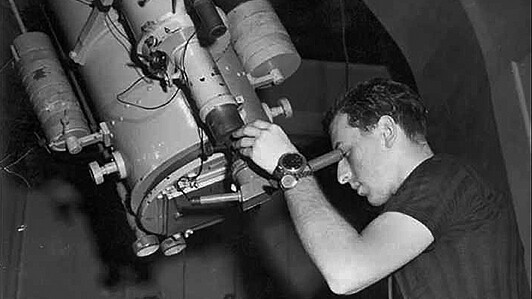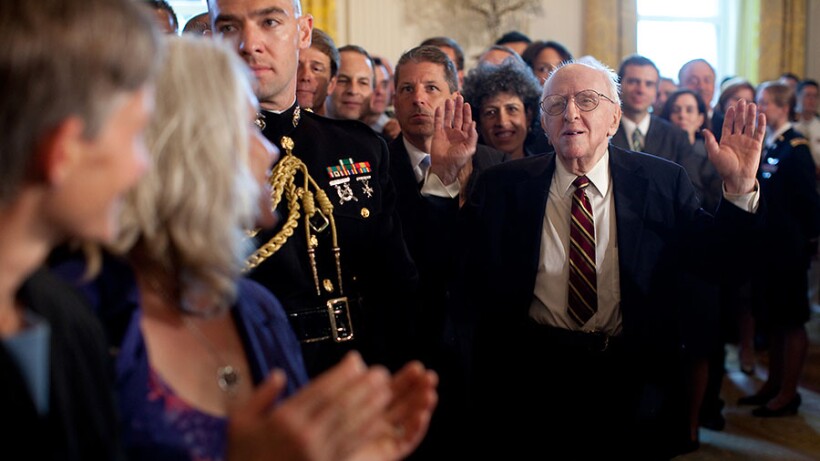For Pride Month, we are reprinting an article by Kai Hostetter-Habib on Frank Kameny, an astronomer whose scientific career was destroyed when he was fired by the US government for being gay. Kameny went on to be a major early activist for LGBTQ+ rights, and the 100th anniversary of his birth was widely celebrated
The Space Race was a time of remarkable innovation and progress in US space science and exploration. Yet, even as the federal government was pouring money and resources into the natural sciences, it was also pushing out scientists, engineers, and other government employees that it deemed unfit. During the Lavender Scare of the mid-twentieth century, the US dismissed thousands of LGBTQ+ public servants, robbing them of their careers and their legacies.
One of them was Frank Kameny, often referred to as the grandfather of the gay rights movement. He became an activist after he was fired from his job as an astronomer at the Army Map Service.
Despite Kameny’s renown in the gay rights movement, his work in astronomy is relatively unknown. In addition to previous interviews and biographical accounts, his papers in the Library of Congress offer perspective on his astronomical achievements. The story of Kameny and the science he only briefly got to pursue is a reminder of the importance of spotlighting those who were denied the opportunity to leave a mark on their fields.

Frank Kameny in 1948.
Photo from the Library of Congress
An “unwavering” pursuit of astronomy
Franklin Edward Kameny was born on May 21, 1925, in Queens, New York, to a middle-class Jewish family. By age four, Kameny knew he wanted to be a scientist, and by seven he had decided on astronomy. He frequently visited the local planetarium and studied the night sky with his telescope, and he founded his high school’s astronomy club.
In 1943, Kameny paused his physics studies at Queens College to enlist
As a PhD student, Kameny dove into photoelectric photometry, an emerging field spurred by the new commercial availability of photomultiplier tubes. With their increased sensitivity compared with photographic plates, the tubes could detect photons from lower-flux astronomical objects and convert them into electric signals. For his thesis, Kameny measured the light curves of RV Tauri
Kameny also served as manager of George R. Agassiz Station, a Harvard observatory located about 50 kilometers west of the university. There, he and fellow student Harlan James Smith improved the high-vacuum aluminization process, a method for coating telescopic mirrors. They realized that if they depressurized the aluminizing chamber using vacuum equipment, a thin film of aluminum would coat the glass substrate evenly—a process known as vacuum metallization. After aluminizing the observatory’s 61-inch reflector, they wrote an authoritative 171-page manual on the technique.
Lavender Scare
By the time Kameny had completed his doctoral thesis in 1956, he had realized his sexuality and dived into the underground gay scene. He later recalled: “I took to it like a duck to water, as if it were made for me or I for it!” At the time, sodomy was a crime in all 50 states and the District of Columbia, and sodomy laws were used by authorities to arrest those deemed to be gay.
On August 28, 1956, after attending the closing banquet of an American Astronomical Society conference in Berkeley, California, Kameny traveled to San Francisco. That night, another man followed Kameny into a train station restroom—a popular gay cruising site—and “touched the private parts” of Kameny for some five seconds. Unbeknownst to them, the San Francisco Police Department had been observing Kameny for a half hour. Upon leaving, Kameny was arrested and charged with “lewd and indecent conduct.” Kameny later recounted in a letter to a gay rights advocacy group that the engagement was nonconsensual.
Because it was a minor charge, Kameny thought little of it and continued with his life. He was entering the workforce at a time when the US was competing with the USSR to launch the first satellite, and there were ample job opportunities for space scientists. Kameny relocated to Washington, DC, where he became a research associate at the Georgetown College Observatory and continued his work on photoelectric photometry. In 1957, Kameny took a job with the Army Map Service, where he supervised observing teams and assembled photoelectric observations of stellar occultations. His sky surveys would be used to determine precise distances between locations and help to guide missiles.

Kameny uses a telescope, most likely during his time as a Harvard graduate student, in an undated photo.
Photo from Library of Congress
But on October 24, 1957, just 20 days after the Soviet launch of Sputnik 1 sparked new urgency in the US space program, Kameny’s career came crashing down. While conducting research in Hawaii, he received a summons from the Army Map Service. The federal government had learned of his 1956 arrest. Kameny was fired in December and, a month later, had his security clearance revoked.
During that time, LGBTQ+ individuals were broadly regarded as mentally ill and subject to blackmail, making them a security risk in the eyes of a government obsessed with preventing alleged subversion by communists. Following President Dwight Eisenhower’s 1953 Executive Order 10450
Kameny was one of an estimated 5,000 to 10,000 people
In the aftermath, Kameny struggled to find work in astronomy. Although scientists and other professionals praised his qualifications, including his “outstanding background and accomplishments,” Kameny was rejected from institutions such as Johns Hopkins University and MIT. He managed to find temporary, menial jobs at optics laboratories and companies. Even as the government and its contractors were scrambling to reinforce the nation’s scientific workforce to win the Space Race, they refused to hire Kameny because he was gay.
Activism and advocacy
Rather than accepting the dismissal, Kameny fought the decision, becoming the first of those who were fired to challenge the government directly. Incensed by the loss of his scientific career, Kameny wrote to Eisenhower: “I have been directing my efforts for over 25 years—since childhood—toward making Astronomy my profession. The Civil Service Commission’s action, if allowed to stand, will completely end my professional and scientific career.” He ultimately appealed his case to the Supreme Court in 1960. Unable to find legal representation, Kameny drafted a 64-page petition requesting that the court hear his case. It refused to do so.
Nonetheless, Kameny continued his work advocating for gay rights and social justice. He led the Mattachine Society
In 1969, Kameny turned his attention fully to advocacy. In 1971, he became the first openly gay candidate to run for Congress. The next year, he helped force the American Psychiatric Association to hold a panel at its annual meeting to discuss the classification of homosexuality as a mental illness. At the panel, he and other gay rights activists rebutted its classification, and at a later special session on homosexuality, Kameny served as the chief discussant. His actions played a pivotal role both in the association’s 1973 decision to declassify homosexuality as a disorder and in the Civil Service Commission’s reversal of Eisenhower’s executive order two years later.
Until his death in 2011—on October 11, National Coming Out Day—Kameny continued to influence public policy and advocate for equal rights. He became involved with local politics: serving on Washington, DC’s Human Rights Commission, assisting in the repeal of the district’s sodomy law, and becoming a staunch advocate for DC statehood.

Kameny is honored at the White House in 2009.
Pete Souza / The White House
Although progress has been made in the nearly 70 years since Kameny’s dismissal from the Army Map Service, LGBTQ+ physicists today say they often feel excluded by the physics community. In a 2022 survey
As a community, physicists continue to fail their LGBTQ+ colleagues. Only by improving the communities we inhabit, particularly for those of marginalized backgrounds, can physics excel.
Sources
On Kameny, see also Eric Cervini, The Deviant’s War: The Homosexual vs. the United States of America
Contact:
Jon Phillips
American Institute of Physics
jphillips@aip.org
Sign up to receive the Weekly Edition and other AIP newsletters by email here.


